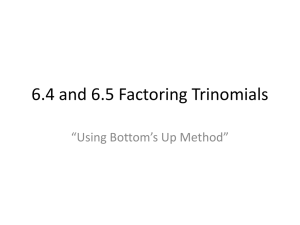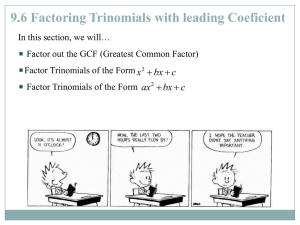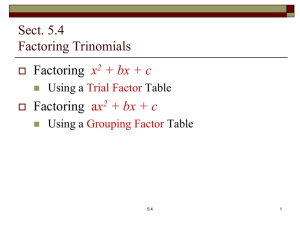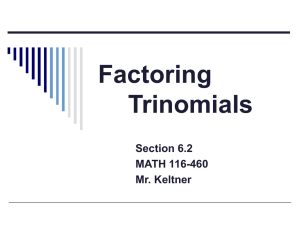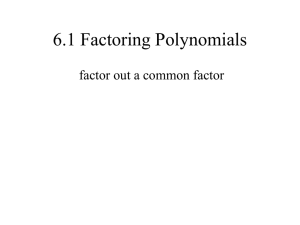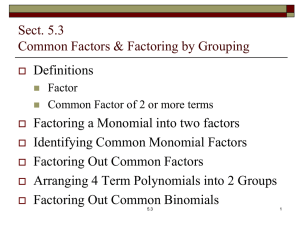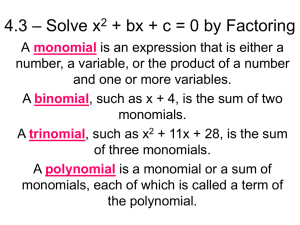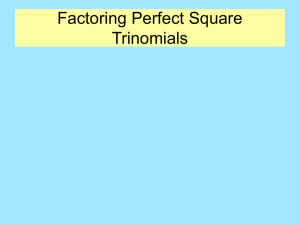SECTION 7.3: Factor By Grouping
advertisement
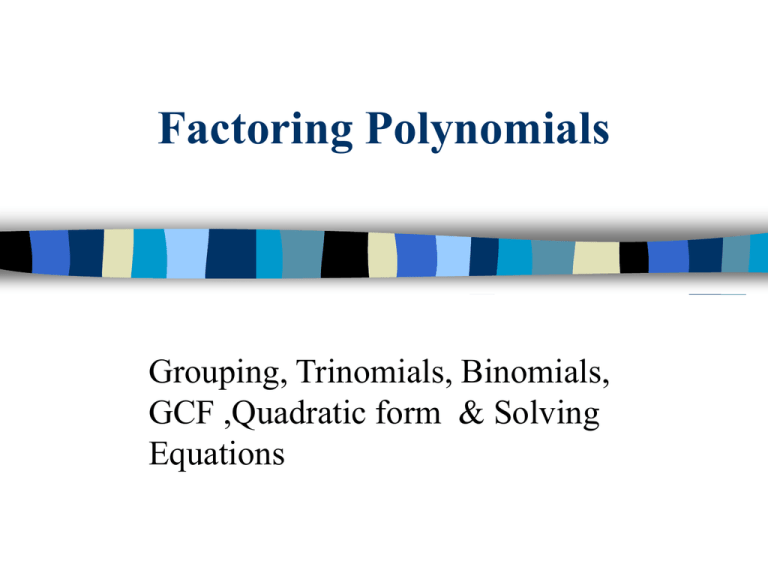
Factoring Polynomials
Grouping, Trinomials, Binomials,
GCF ,Quadratic form & Solving
Equations
Student will be able to Factor
by Grouping terms
When polynomials contain four terms, it
is sometimes easier to group like terms in
order to factor.
Your goal is to create a common factor.
You can also move terms around in the
polynomial to create a common factor.
Practice makes you better in recognizing
common factors.
Factoring Four Term
Polynomials
Do now: find the GCf of the first two terms and the last two terms:
3x 12x 6x 24
3
2
2
3x
and 6
Group together and Factor each one
separately:
(3x 12x ) (6x 24)
3
2
3x (x 4) 6(x 4)
2
They share a common factor of (x-4)
Write 2 factors:
Write the common factor once and put
the outside terms together:
(3x 3 12x 2 ) (6x 24)
3x 2 (x 4) 6(x 4)
(3x 2 6)(x 4)
Factor by Grouping
Example 1:
FACTOR: 3xy - 21y + 5x – 35
Factor the first two terms:
3xy – 21y
Factor the last two terms:
+ 5x - 35 =
Factor by Grouping
Example 1:
FACTOR: 3xy - 21y + 5x – 35
Factor the first two terms:
3xy - 21y = 3y (x – 7)
Factor the last two terms:
+ 5x - 35 = 5 (x – 7)
The green parentheses are the same so
it’s the common factor
Factor by Grouping
Example 1:
FACTOR: 3xy - 21y + 5x – 35
Factor the first two terms:
3xy - 21y = 3y (x – 7)
Factor the last two terms:
+ 5x - 35 = 5 (x – 7)
The green parentheses are the same so
it’s the common factor
Now you have a common factor
(x - 7) (3y + 5)
Factor by Grouping
Example 2:
FACTOR: 6mx – 4m + 3rx – 2r
Factor the first two terms:
6mx – 4m =
Factor the last two terms:
+ 3rx – 2r =
Factor by Grouping
Example 2:
FACTOR: 6mx – 4m + 3rx – 2r
Factor the first two terms:
6mx – 4m = 2m (3x - 2)
Factor the last two terms:
+ 3rx – 2r = r (3x - 2)
The green parentheses are the same so
it’s the common factor
Now you have a common factor
(3x - 2) (2m + r)
Factor by Grouping
Example 3:
FACTOR: y3– 5y2 -4y +20
Factor by Grouping
Example 3:
FACTOR: y3– 5y2 - 4y +20
Factor the first two terms:
y3– 5y2 = y2 (y - 5)
Factor the last two terms:
- 4y +20 = -4 (y – 5)
The green parentheses are the same!
y2 (y - 5) and -4 (y - 5)
Now you have the difference of two squares!
look at red ( ):
(y - 5) (y2 - 4) :
answer: (y - 5) (y - 2) (y + 2)
See worksheet “Factor by
grouping”
Try first 4 problems.
Using Factor by Grouping to solve a polynomial
function:
From the last example, suppose it was an equation…..
y3– 5y2 - 4y +20 = 0
(y - 5) (y - 2) (y + 2) = 0
y=5 y = 2 y=-2
So the solution set is { 5,2,-2}
Factor first, then set factors = 0
3x 12x 6x 24 0
3
2
(3x 2 6)(x 4) 0
3x 2 6 0 X-4=0
solve
3x 12x 6x 24 0
3
2
(3x 2 6)(x 4) 0
3x 2 6 0
3x 6
X-4=0
2
x2 2
X=4
x 2
{4, 2, 2}
Hand this one in:
Solve for all roots:
3x3 - 4x2 -27x +36 = 0
Factoring Trinomials
Factoring Trinominals
1. When trinomials have a degree of “2”,
they are known as quadratics.
2. We learned earlier to use the last term’s
factors to factor trinomials that had a
“1” in front of the squared term.
x2 + 12x + 35
So… 7 and 5 or 35 and 1
Factoring Trinominals
1. When trinomials have a degree of “2”,
they are known as quadratics.
2. We learned earlier to use the last term’s
factors to factor trinomials that had a
“1” in front of the squared term.
x2 + 12x + 35
(x + 7)(x + 5)
Because 7 + 5 = 12!
More Factoring Trinomials
3. When there is a coefficient larger than
“1” in front of the squared term, we can
use a method we will call, the “am” add,
multiply method to find the factors.
3. Always remember to look for a GCF
before you do ANY other factoring.
More Factoring Trinomials
5. Let’s try this example
3x2 + 13x + 4
(3x )(x )
Write the factors of the last term…1,4 2,2
Multiply using foil until you get the middle
term of the trinomial. If so, you’re
done!
More Factoring Trinomials
3x2 + 13x + 4
(3x + 1 )(x + 4 )
3x2 + 12x + 1x + 4
= 3x2 + 13x + 4 ✓
Difference of Squares
Difference of Squares
When factoring using a difference of
squares, look for the following three
things:
– only 2 terms
– minus sign between them
– both terms must be perfect squares
– No common factors
If all of the above are true, write two
( ), one with a + sign and one with a – sign
: ( + ) ( - ).
Try These, (if possible)
1.
2.
3.
4.
5.
6.
a2 – 16
x2 – 25
4y2 – 16
9y2 – 25
3r2 – 81
2a2 + 16
answers:
1.
2.
3.
4.
5.
6.
a2 – 16 (a + 4) (a – 4)
x2 – 25 (x + 5) (x – 5)
4y2 – 9 (2y + 3) (2y – 3)
9y2 – 25 (3y + 5) (3y – 5)
3r2 – 81 *3 is not a square!
a2 + 16 Not a difference!
Perfect Square Trinomials
Perfect Square Trinomials
When factoring using perfect square
trinomials, look for the following three
things:
– 3 terms
– last term must be positive
– first and last terms must be perfect
squares
If all three of the above are true, write
one ( )2 using the sign of the middle
term.
Try These
a2 – 8a + 16
2. x2 + 10x + 25
3. 4y2 + 16y + 16
4. 9y2 + 30y + 25
1.
Factoring Completely
Factoring Completely
Now that we’ve learned all the types of
factoring, we need to remember to use them all.
Whenever it says to factor, you must break
down the expression into the smallest possible
factors.
Let’s review all the ways to factor.
Types of Factoring
1. Look for GCF first.
2. Count the number of terms:
a) 4 terms – factor by grouping
b) 3 terms 1. look for perfect square trinomial
2. if not, try “am” method
c) 2 terms look for difference of squares
If any ( ) still has an exponent of 2 or
more, see if you can factor again.
These may take 2 steps!
1. 3r2 – 18r + 27
2. 2a2 + 8a - 8
Answers:
1. 3r2 – 30r + 27
3(r2 - 10r + 9)
3(r – 9) (r – 1)
2. 2a2 + 8a – 8
2(a2 + 4a – 4)
Solving Equations by Factoring
Completely
Do Now:
1)Factor completely
2)Solve for x
1) x 4 x
5
2
2) 3x 18x 27 0
2
Steps to Solve Equations by Factoring
Completely
set each factor = 0 and solve for the unknown.
x3 + 12x2 = 0 1. Factor GCF
x2 (x + 12) = 0
Steps to Solve Equations by Factoring
Completely
set each factor = 0 and solve for the unknown.
x3 + 12x2 = 0 1. Factor GCF
x2 (x + 12) = 0 2. (set each factor = 0, & solve)
x2 = 0
x + 12 = 0
x=0
x = -12
You now have 2 answers, x = 0 and x = -12
Factor completely:
x x 12x 0
3
2
Factor completely:
x x 12x 0
3
2
x(x x 12) 0
x(x 4)(x 3) 0
2
X=
0 , 4 , 3
Solving higher degree functions
Quadratic form:
ax4 + bx2 + c = 0
Example: x4 +2x2 -24 = 0
Factor: (x2
)(x2 )=0
Solving higher degree functions
Quadratic form:
ax4 + bx2 + c = 0
Example: x4 +2x2 -24 = 0
Factor: (x2 +6 )(x2 – 4 ) = 0
x2 +6=0
x2 – 4 =0
x2 =-6
x2 = 4
x = 2, -2
x i 6
Try this one:
X4 – 13x2 +36 = 0
Factor first:
X4 – 13x2 +36 = 0
(x2 – 9)(x2 – 4)=0
Solutions:
X4 – 13x2 +36 = 0
(x2 – 9)(x2 – 4)
X2-9=0 x2-4=0
X=3,-3
x= 2,-2
This one can be verified on the calculator.
X = 2,-2,3,-3
Hand this one in
Quadratic form:
x 6x 27 0
4
2
Ans: x 4 6x 2 27 0
X=
(x 9)(x 3) 0
2
2
x 9 0 x 3 0
2
2
x 9 , x 3
2
2
x 3i,3i , x 3, 3

